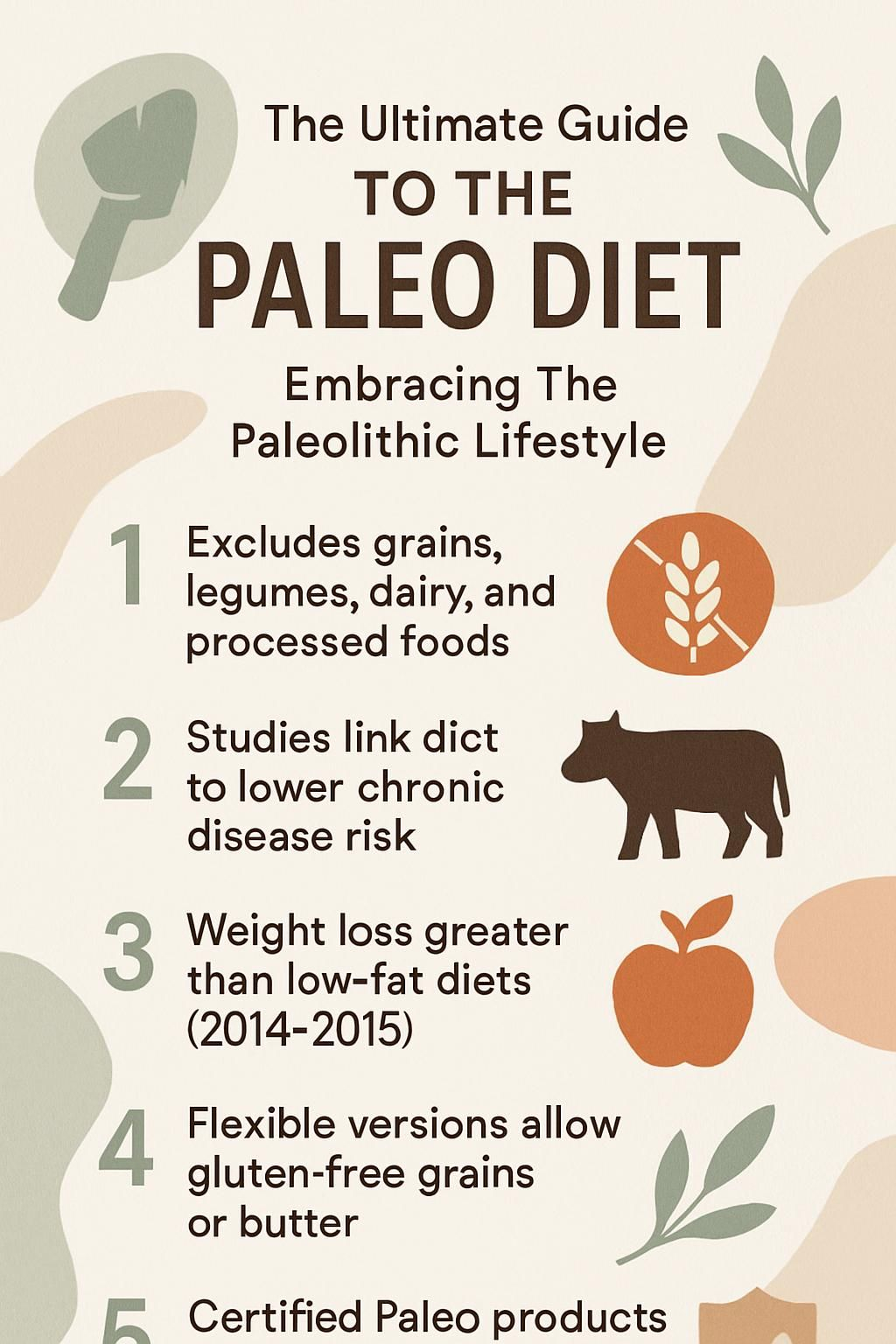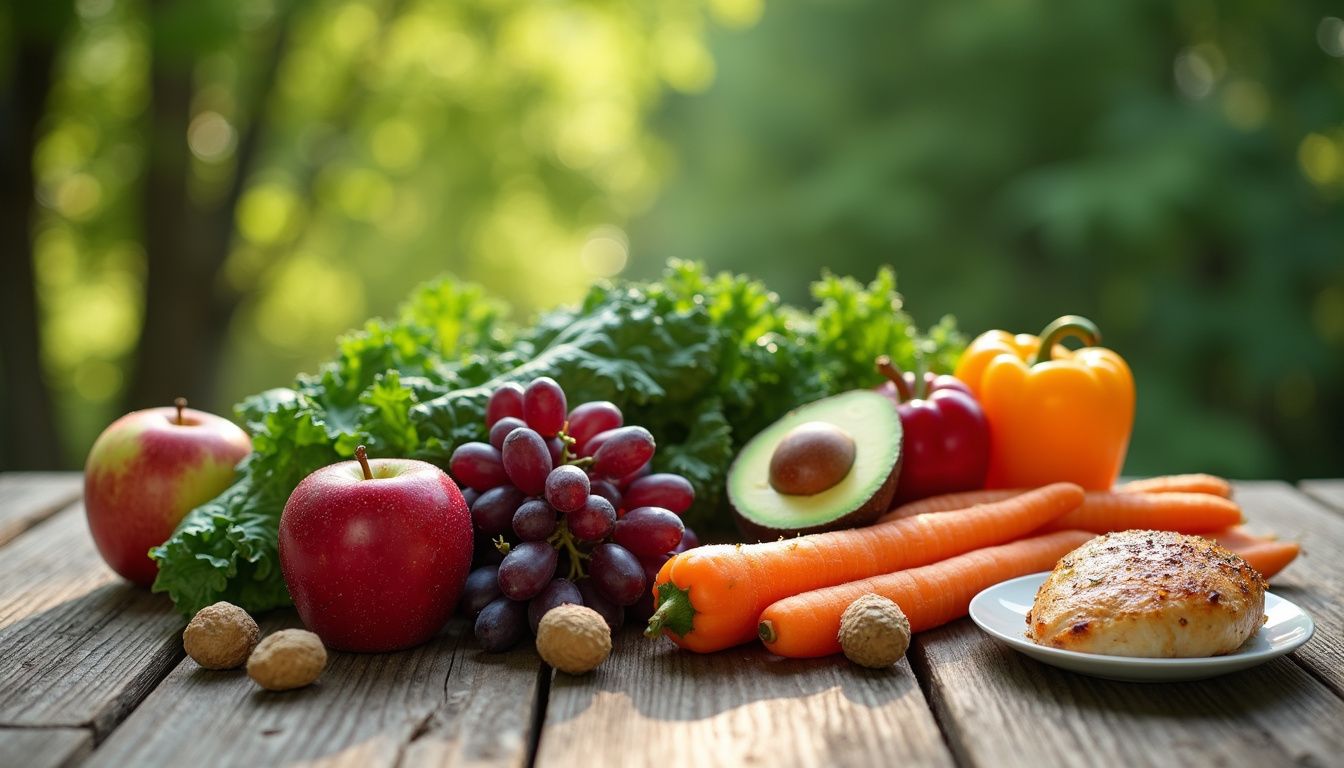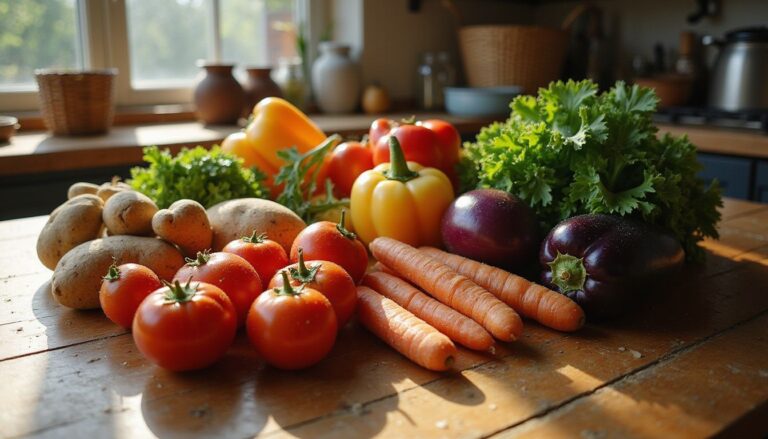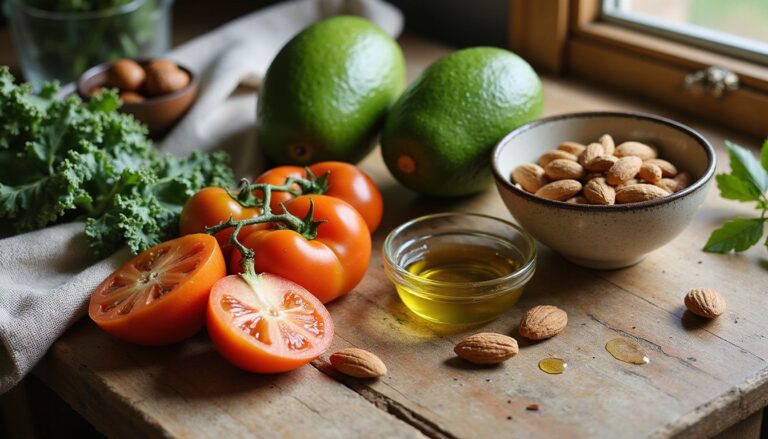The Ultimate Guide To The Paleo Diet: Embracing The Paleolithic Lifestyle
Our Nutrition Assistant AI Suite will transform your body. You will lose fat, get toned, and build muscle. Gain confidence and optimal health.
Many people feel stuck with their eating habits and want a plan that supports steady energy, a healthy weight, and better health. I have felt that frustration too. The paleo diet gave me a simple framework that focused on real food I could recognize.
In this guide, you will find clear facts on the Paleolithic lifestyle and a practical meal plan. I share how I use fresh foods like lean meat, fish, fruits, vegetables, and nuts, and how cutting highly processed food changed my results. You will also see where the plan is flexible and where it is strict so you can choose what fits your life.
Some research links a paleo-style pattern to better weight control and improved heart markers, such as blood pressure and triglycerides. While results vary, reducing added sugar and ultra-processed snacks often helps people feel and perform better. Want to learn which foods make this plan work? Keep reading.
Key Takeaways
- The paleo diet avoids grains, legumes, dairy, processed foods, added sugar, and most refined oils. It centers on lean meat, wild fish, eggs, fruits and vegetables, nuts and seeds, and healthy fats like olive oil.
- Small trials from 2014 to 2015 found greater weight loss with paleo-style eating than with low-fat or Mediterranean plans, likely due to higher protein and fewer empty calories.
- Studies, including Cordain et al. 2005, link an emphasis on unprocessed foods to better blood sugar control and lower inflammation markers in some people.
- Strict versions exclude all dairy and grains. Flexible versions may allow grass-fed butter or gluten-free grains to help with calcium and personal tolerance.
- Paleo-labeled products are easier to find now. Reputable medical sources, such as the Mayo Clinic, share recipes and planning tips that make daily practice simpler.

Overview of the Paleo Diet and its growing popularity
The paleo diet has moved into mainstream news on shows like Good Morning America and NBC News. Many brands now seek paleo-style seals on their labels, and stores place these items in easy-to-find sections.
Mayo Clinic articles, newsletters, and app content explain this stone age diet with practical meal plans and shopping advice. Social platforms amplify the message as dietitians and trainers show simple ways to eat fewer highly processed foods.
I began my own journey after hearing a registered dietitian explain why the caveman diet centers on whole foods and trims grains, processed snacks, legumes, most dairy, and refined sugar. That one talk made the plan feel doable.
Paleo is not just about weight loss. It can be a steady way to eat better food and feel more in control.
Interest keeps growing as clinicians discuss how a whole-food pattern may support healthy digestion and weight management. Evidence is still evolving, so I treat new claims with care and focus on what I can apply today.
Explanation of the Paleolithic lifestyle and its principles
I use a simple rule, eat foods our hunter-gatherer ancestors could have gathered or hunted. That means fruits, vegetables, fish, lean meats, eggs, nuts, seeds, and fats from olives, coconuts, or avocados.
I skip grains like wheat and rice, legumes like beans and lentils, most dairy, ultra-processed foods, added sugars, and seed oils made with heavy processing. The idea is to reduce food processing and focus on quality.
Science suggests that nutrient-dense, minimally processed food patterns may support better health by lowering inflammation markers. I also notice steady energy when my plate is mostly plants with a portion of lean protein. I do not count every calorie. Instead, I choose the best food I can afford and keep my meals simple.
What is the Paleo Diet?

The paleo diet is an eating plan based on foods people could access during the Paleolithic era. Think of it as a return to simple, whole ingredients that your grandparents would recognize.
Definition and historical background
The Paleolithic era lasted from about 2.5 million to 10,000 years ago. People ate what they hunted and gathered, such as lean meat, fish, roots, nuts, seeds, fruits, and wild greens. Agriculture started later, so grains, beans, and dairy appeared after that shift.
Archaeologists have found grinding stones and plant remains that suggest some groups ate small amounts of wild grains. Over time, human genes adapted to farming foods, like better starch digestion and, in some groups, lactose tolerance. These changes varied by region and culture.
This eating style is often called the stone age diet or caveman diet. It aims to favor foods with minimal processing while avoiding modern snacks and sugary drinks.
To eat closer to our early diet is more than a trend, it reflects our biology and how we evolved.
Key differences between Paleo and other dietary approaches
Many plans improve health. Paleo stands out because it chooses food by source and processing level, not by strict macronutrient targets. Here is how it compares to other common approaches.
| Aspect | Paleo Diet | Mediterranean Diet | DASH Diet | Vegan/Vegetarian Diet |
|---|---|---|---|---|
| Grains | Excludes all grains (wheat, oats, barley, rice) | Includes whole grains | Includes whole grains | Includes whole grains |
| Legumes | Excludes all beans, lentils, peanuts | Includes legumes | Includes legumes | Includes legumes |
| Dairy | Excludes dairy products; some versions allow grass-fed butter | Includes low-fat dairy | Emphasizes low-fat dairy for calcium | Excludes dairy (vegan); may include (vegetarian) |
| Processed Foods | Excludes all processed foods like chips, cookies | Allows in moderation | Allows in moderation | Allows in moderation |
| Added Sugar | Eliminates refined and added sugars | Limits added sugar | Allows small amounts | Permits if plant-based |
| Macronutrient Focus | No set ratios; focuses on food type quality | Balanced macronutrients | Low sodium, moderate fat | High carbohydrate, low fat (vegan) |
| Animal Products | Prioritizes lean meats, fish, eggs | Includes fish, seafood, moderate poultry | Includes lean meats, fish | Excludes (vegan); may allow eggs, dairy (vegetarian) |
| Flexibility | Some allow gluten-free grains, grass-fed butter | Very adaptable | Flexible within guidelines | Adapts based on plant or animal product preferences |
| Suitability for Vegans/Vegetarians | Not practical, excludes legumes and relies on animal foods | Can be vegetarian or pescatarian | Can be vegetarian or pescatarian | Suitable |
Foods to Include in a Paleo Diet
The paleo diet includes colorful, nutrient-dense foods that are simple to prepare. Think fresh produce, quality proteins, and fats from plants.
Lean meats and fish
Grass-fed and wild meats play a central role on my menu. I often choose lean beef, chicken thighs, or turkey as the base of meals. Grass-fed cuts tend to have more omega-3 fats and vitamin E than grain-fed options.
Wild fish like salmon, trout, and sardines add high-quality protein and omega-3 fats that support heart health. A baked salmon with roasted carrots and potatoes is one of my go-to dinners. Eggs are also a budget-friendly protein with vitamin D.
These proteins keep me full for hours, which helps with weight goals and steady energy.
Fresh fruits and vegetables
Fresh fruits and vegetables are the foundation of my plate. I rotate berries, melon, tomatoes, cucumbers, leafy greens, broccoli, and carrots for color and variety. The mix delivers vitamins, minerals, and fiber for gut health.
I like quick sides such as a spicy melon salad or crunchy jicama sticks with a citrus dip. Grilled mushroom skewers make a tasty plant-based side next to fish or chicken. Most reviews of paleo-style eating agree that plenty of produce is key.
Nuts and seeds
Nuts and seeds bring healthy fats, fiber, and minerals. I keep almonds, walnuts, and pumpkin seeds handy for snacks or salad toppers. Many of these provide magnesium, a mineral that supports muscle and nerve function.
Almond butter is a staple for me because it spreads well on apple slices or carrot sticks. Toasted nuts add crunch to a simple greens bowl. Seeds are small, but they pack useful fiber that helps with fullness and regularity.
Healthy fats (olive oil, coconut oil, avocado)
Olive oil, coconut oil, and avocado show up in my kitchen every day. Extra-virgin olive oil works well for low to medium heat cooking and dressings. Research links olive oil to healthier heart markers when used in place of refined fats.
Coconut oil handles higher heat for sautéing. Avocado delivers creamy texture and monounsaturated fat, which supports healthy cholesterol levels. Using these fats adds flavor without relying on sugary sauces.
Foods to Avoid on the Paleo Diet
To follow paleo principles, I limit foods introduced after farming and modern processing began. Removing them keeps choices simple and nutrient dense.
Grains and legumes
Grains such as wheat, oats, barley, and rice are not part of a strict paleo plan. Legumes like beans, lentils, and peanuts are excluded too. While these foods can be healthy in other diets, they do not fit the original paleo template.
Skipping grains and legumes may lower fiber intake if you are not careful. I balance that by eating more vegetables, berries, and nuts. This helps me keep digestion regular while staying within paleo rules.
Dairy products
Milk, yogurt, and cheese are excluded in classic paleo eating. Some people miss the taste and the calcium. Flexible versions may allow grass-fed butter or small amounts of full-fat dairy, based on personal tolerance and goals.
If you avoid dairy, plan for calcium and vitamin D from other sources, such as leafy greens, fish with bones, and sunlight or supplements if your clinician recommends them.
Processed foods and added sugars
I removed packaged snacks, sweets, and sugar-sweetened drinks. These products often include refined sugar, salt, and additives. Cutting them reduced my cravings and made room for real food.
Artificial sweeteners do not fit classic paleo either. When I want something sweet, I choose fresh fruit. That shift alone improved my appetite control.
Refined oils
I avoid most seed oils made with heavy processing, such as soybean, canola, corn, sunflower, and safflower oils. These are common in packaged foods and many condiments.
Instead, I cook with olive oil, avocado oil, or small amounts of unrefined nut oils. Choosing simpler fats keeps the plan aligned with its whole-food focus.
Health Benefits of the Paleo Diet
Many people report progress with weight, energy, and lab markers after moving to a paleo-style pattern. Results depend on your starting point and consistency.
Weight loss and management
Paleo eating often leads to fewer empty calories and more protein. Studies from 2014 and 2015 found that people on paleo plans lost more weight than those on low-fat or Mediterranean plans during the study periods. Higher protein helps with fullness, and fewer processed snacks cut extra sugar and fat.
My portions feel easier to manage because real food is satisfying. I do not chase perfection, I build better habits one meal at a time.
Improved digestion and gut health
Eating more plants and fewer ultra-processed foods helped my digestion. I had some early bloating when I increased fiber quickly, so I eased in over a week. Many people notice clearer skin and less stomach discomfort after reducing added sugars.
Removing dairy or legumes affects people differently depending on genes and tolerance. I track how I feel, then adjust my plan. The Mayo Clinic shares gut-friendly recipes that make this easier.
Enhanced energy levels
Once I shifted to lean proteins, vegetables, and fruit, my energy felt more stable. I no longer hit the mid-afternoon crash I had with sweet snacks. Balanced meals with healthy fats, like olive oil and avocado, support steady fuel across the day.
Active people often report better endurance with a whole-food pattern. That has been true for me during busy weeks and travel days.
Reduced inflammation and chronic disease risk
A diet rich in produce, fish, nuts, and unprocessed meat may reduce inflammation markers. Some studies link paleo-style patterns to better cholesterol and blood pressure. Similar benefits appear in a Mediterranean approach, which also highlights whole foods.
Less added sugar, fewer refined oils, and fewer ultra-processed snacks can support long-term health. These swaps are simple, and they add up over time.
Getting Started with the Paleo Diet
Starting small works best. Make a short plan, stock your kitchen, and build wins early.
Tips for transitioning to a Paleo diet
I began with a one-week menu to remove guesswork. I prepped simple snacks like toasted nuts, hard-boiled eggs, and sliced fruit and vegetables. I changed my meals gradually to avoid stomach upset as my fiber intake rose.
Keeping a few paleo-certified items on hand made hectic days easier. I used Mayo Clinic content for ideas and swapped slowly instead of all at once. If you live with a medical condition like diabetes, talk with a healthcare professional before you start. A brief check-in can keep the plan safe and effective for you.
Meal planning and preparation strategies
New routines feel lighter with a plan. I build weekly menus around seasonal produce and basic proteins. Batch-cooking chicken, turkey, or ground beef saves time for weeknights.
I prepare jar salads with spinach or kale, berries, and chopped nuts. For cooking, I use olive oil or avocado oil. I avoid sugary condiments and brighten flavor with herbs, spices, and lemon juice.
I also pack a few grab-and-go snacks, like eggs or small bags of nuts. This keeps me on track at work or on the road. Since 2022, these steps have helped me stay consistent during travel and long meeting days.
Grocery shopping for Paleo-friendly foods
I shop the outer aisles first. My cart includes lean meat, poultry, wild-caught fish, eggs, fresh or frozen produce, berries, nuts and seeds, olive oil, avocado oil, sweet potatoes, and spices. When possible, I choose grass-fed beef or bison and wild salmon for more omega-3 fats.
I read labels and skip items with grains, dairy, legumes, added sugar, or refined seed oils. Simple ingredient lists make choices easier. Nuts and seeds work well as balanced snacks that do not spike blood sugar.
For quick breakfast options, I sometimes make chia pudding with matcha and top it with berries. Mushroom skewers with a big salad are another fast meal I rely on.
Common Challenges and How to Overcome Them
I faced tough moments with cravings, social events, and food costs. Small systems helped me stay on track without feeling rigid.
Dealing with cravings for non-Paleo foods
Cravings can spike in the first few weeks. I keep toasted nuts, eggs, berries, and cut vegetables ready to go. These choices help with fullness and reduce the urge to reach for sweet snacks.
A square of dark chocolate with at least 70 percent cocoa or a small glass of red wine can fit into flexible versions of paleo. I also make comfort foods with paleo swaps, like roasted sweet potatoes instead of fries. Meal prep and steady routines made cravings fade over time. Studies suggest that nutrient-dense meals curb urges by stabilizing blood sugar1.
1. Cordain L et al. Origins and Evolution of the Western Diet: Health Implications for the 21st Century. American Journal of Clinical Nutrition. 2005;81(2).
Dining out and social situations
I check menus online and pick a protein with extra vegetables. I ask for olive oil on the side, skip bread and rice, and request simple seasonings. These small questions help me keep meals aligned with my plan.
For gatherings, I bring a paleo-friendly dish or carry nuts and fruit in case options are limited. Many places now offer gluten-free meals that can be adapted to paleo. Consistency matters more than perfection at a single meal.
The cost of following a Paleo diet
Quality meat and fish can be pricey, and produce adds up too. I reduce costs by buying frozen vegetables and berries, choosing less expensive cuts, and using local markets. Bulk purchases of meat, nuts, and pantry staples also help.
Seasonal produce costs less and tastes better. Planning a simple menu keeps my cart focused on essentials. Batch cooking reduces food waste and saves money during the week.
Paleo Diet Variations and Adaptations
People follow paleo in different ways. You can stay strict or allow a few modern foods if they work for you.
Differences between strict and flexible approaches
Strict paleo removes grains, legumes, dairy, processed foods, and refined seed oils. Flexible versions may allow grass-fed butter, full-fat yogurt, or gluten-free grains for practicality and calcium. I pick my lane based on goals, budget, and how my body responds.
Strict plans match the original template closely. Flexible plans treat paleo as a guide, not a rulebook. Both focus on whole foods, plenty of plants, lean proteins, nuts, and seeds. A small amount of honey or coffee can fit for many people without derailing progress.
Incorporating intermittent fasting or other eating patterns
Meal timing can support results. Some people pair paleo with intermittent fasting, which means eating within a set daily window. Mayo Clinic resources describe fasting as one tool for metabolic health, but it is not required.
I have used shorter eating windows on busy days. It helped me avoid constant snacking and stay focused on whole meals. Whether you choose time-restricted feeding or a regular schedule, the quality of your food still matters most.
Exercise and the Paleo Diet
Food is fuel, and movement puts that fuel to work. I see the best results when I eat well and move often.
The importance of physical activity in a Paleo lifestyle
Hunter-gatherer life involved steady movement, like walking, carrying, and occasional sprinting. Regular activity supports strong muscles, a healthy weight, and a resilient immune system. In my routine, daily walks and simple strength training improved sleep and focus.
Research suggests that a mix of movement and whole-food eating may reduce inflammation. That combination supports long-term health.
Recommended types of exercise for optimal results
I aim for natural movement patterns. Walking most days supports heart health and fat loss. I add short intervals, like sprints, to mimic varied effort. Lifting heavy objects, using bodyweight, or training with sandbags builds strength and bone density.
Outdoor play, hiking, and easy mobility drills keep joints happy. Studies show that varied routines can reduce inflammation markers and raise energy across the day2. These sessions pair well with a plate full of produce, lean protein, and healthy fats.
2. Smith et al. Journal of Nutrition & Physical Activity Patterns. 2022.
Conclusion
I enjoy sharing what the paleo diet has done for me, and what it might do for you. The plan is simple, but it still needs a little structure and patience.
Recap of the benefits and principles of the Paleo Diet
The paleo diet focuses on whole foods from the Paleolithic era, such as lean meat, wild fish, eggs, vegetables, fruits, nuts, seeds, and plant-based oils like olive and avocado. It removes grains, legumes, most dairy, processed foods, added sugar, and refined seed oils.
People often report weight loss, better digestion, higher energy, and improved cardiometabolic markers. Evidence suggests that eating fewer ultra-processed foods supports long-term health. Flexibility can help you stay consistent while keeping core principles intact.
Encouragement to adopt a Paleolithic lifestyle for improved health and wellness
Whole, unprocessed foods make a real difference. Several studies show that a paleo-style plan may support weight loss and heart health within months, especially when paired with regular activity. The pattern is simple, and it can fit busy lives with a bit of planning.
If you have specific needs or a condition like diabetes, speak with a healthcare professional before you start. Then build your plate, one meal at a time. Small changes add up, and the payoff is feeling and performing better day after day.
FAQs
1. What is the Paleo Diet and what foods does it include?
The Paleo Diet focuses on eating foods that early humans could hunt or gather, such as lean meats, fish, fruits, vegetables, nuts, and seeds. It avoids processed foods, grains like wheat or rice, dairy products from cows or goats, legumes such as beans or lentils, and added sugars.
2. Are there proven health benefits to following a Paleolithic lifestyle?
Research shows that people who follow this diet may see lower blood sugar levels and improved heart health markers compared to those eating modern diets high in refined grains and sugars (Otten et al., 2017). Some studies also report weight loss due to higher protein intake and reduced calorie consumption.
3. Can you share a personal experience with adopting the Paleo Diet?
After switching to this way of eating for three months last year I noticed more stable energy throughout my day. My digestion improved when I replaced bread with sweet potatoes at meals; this change made me feel less bloated after lunch.
4. Is the Paleo Diet suitable for everyone?
This diet may not fit all lifestyles or medical needs. People with certain conditions like kidney disease should consult their doctor before making changes since high protein intake can affect kidney function (Micha et al., 2010). Children and pregnant women need extra nutrients found in some excluded food groups so professional advice is important.
Summary: The Paleolithic approach centers on whole foods available during ancient times while avoiding processed items common today. Evidence suggests possible benefits for blood sugar control and heart health but individual results vary based on personal factors including age or existing medical issues.







